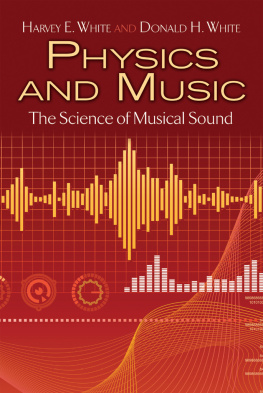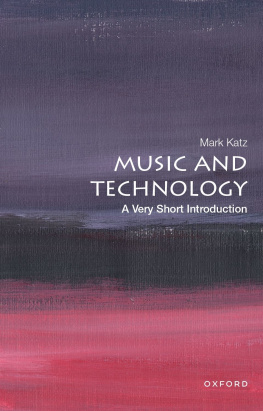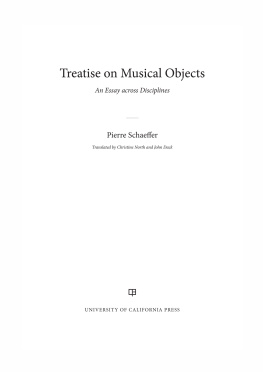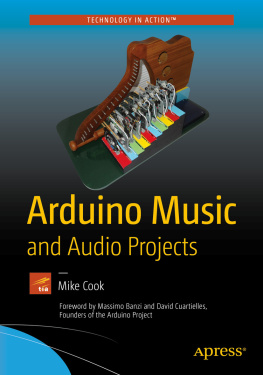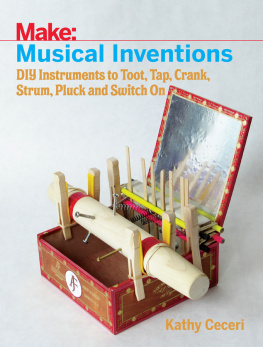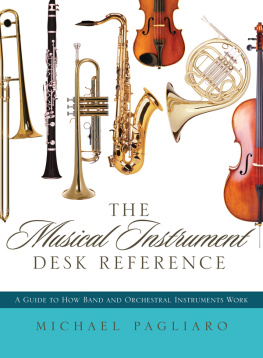P HYSICS
AND M USIC
The Science of Musical Sound
Harvey E. White
Donald H. White

Dover Publications, Inc.
Mineola, New York
To Beverly
Copyright
Copyright 1980 by Saunders College/Holt, Rinehart and Winston
All rights reserved.
Bibliographical Note
This Dover edition, first published in 2014 is an unabridged republication of the work originally published by Saunders College/Holt, Rinehart and Wisnton, Philadelphia, in 1980.
International Standard Book Number
eISBN-13: 978-0-486-79400-6
Manufactured in the United States by Courier Corporation
77934301 2014
www.doverpublications.com
PREFACE
Almost everyone enjoys music, whether as a performer or as a listener. This book is written for the student who wants to go beyond the perceptual stage of music to learn how musical sound is created and why it is perceived as it is. The student does not need a background in science to understand the material presented here. However, he or she should have some knowledge of the structure of music, for example, a familiarity with the piano keyboard.
This text, intended to be self-contained, surveys a wide range of topics related to the acoustics of music. We begin with a brief history of the art and science of music, followed by the general principles of sound, musical scales, and the primary ways in which sound can be generated as well as those characteristics common to all instruments. In later chapters we deal with various mechanical and electronic recording devices, the playback of hi-fi stereophonic and quadrophonic sound, and the design of electronic musical instruments. Finally, we explore the acoustics of auditoriums, concert halls, and outdoor theaters in both perceptual and measurable terms so that the student will be able to analyze or modify the acoustical response of the listening environment.
We have tried to make this text as readable and comprehensive as possible. For example, we have included over 300 diagrams, photographs, and tables as illustrative matter. Algebraic equations are often used to express experimentally based relationships. New terms are set in boldface type since the subject matter introduces a sizeable new vocabulary. These terms are also boldface in the index, which serves as a glossary as well. At the end of each chapter we have included (1) questions to aid the student in reviewing and consolidating the material, (2) problems for students who wish to employ the relationships discussed in the chapter quantitatively, (3) student projects, which can be done at home or in the laboratory, and (4) references for students who want to explore specific topics in depth or concentrate on areas of personal interest.
In recent years the field of musical acoustics has been the scene of considerable interest and activity, both in the classroom and in the research laboratory. New findings are continually being published in technical journals as well as in popular magazines. In treating the central concepts of this book, we have often glossed over interesting details which the student will miss unless he or she supplements this text with additional reading. If students are stimulated to explore some of the byways of acoustics by following up some of the references noted, we will consider this book a success.
In drawing together the considerable material required for the range of topics presented in this text, we have relied upon input and review from many musicians, scientists, and specialists in other areas. We wish to thank Isidor Elias, Santa Barbara City College; Sterling Gorril; Edwin Hahn, University of California, Berkeley; Joseph Hirschberg, University of Miami; David Jasnow, University of Pittsburgh; Martin E. Rickey, Indiana University; Thomas Ross-ing, Northern Illinois University; Larry Rowan, University of North Carolina, Chapel Hill; William R. Savage, University of Iowa; Wave Shaffer, Ohio State University (Emeritus); Daniel Strohl; William E. Vehse, West Virginia University; Gabriel Weinreich, University of Michigan, Ann Arbor; and Robert W. Williams, University of Washington. We are also grateful to Klemi Hambourg, Max Larson, Richard Sorensen, David E. Wallace, and Ronald Wynn of Oregon College of Education for their assistance.
Berkeley, California
Monmonth, Oregon
October, 1979
Harvey E. White
Donald H. White
CONTENTS
PART ONE
The Nature of Sound

Chapter One
THE ART AND SCIENCE OF MUSIC

The word science stems from the Latin root scire, meaning to know. It is a branch of human endeavor in which nature is studied and analyzed in an attempt to understand its structure and behavior. Music is thought of as an art form, a refinement of the production and reception of sound.
1.1 Music of the spheres
Music and science may seem to many to be quite far apart. Yet these subjects are related in many interesting ways. The study of the relation between nature and musical harmony extends back into antiquity. During the sixth century B.C., Pythagoras and his followers). The findings attributed to Pythagoras can be expressed as follows: Pluck a stretched string and perceive its pitch. If now only one-half the length of the string is allowed to vibrate, it will sound an octave higher. If two-thirds of the string is allowed to vibrate, it will sound a perfect fifth higher. A length of three-fourths will sound a perfect fourth higher; and so on. These relationships were perceived as harmonious, in the broadest sense.
The harmonious relationship was recognized in terms of the vibrating portions of the string, expressed as simple mathematical relationships: 2:1= octave, 3:2 = fifth, 4:3 = fourth, and so forth. These perfect musical consonances were directly related to simple relationships of whole numbers.

FIGURE 11 Demonstration of harmonic proportions from Franchino Gafurios Theorica Musice of 1492. In these diagrams Pythagoras is seen with his follower Philolaus demonstrating the tones of bells of different sizes, glasses filled to different levels, strings that are stretched by different weights, and pipes of different lengths.
The ancient Greeks were strongly oriented toward harmonies in nature, and music was simply one of these natural harmonies. The Pythagoreans carried their concept of natural musical harmony far beyond mathematics. They believed that all regularities in nature are musical. In particular, they believed that the planets produced harmonious sounds as they moved in space. This is the music of the spheres, a harmonious relationship of the heavenly bodies.
Various aspects of the Pythagorean school affected the understanding of nature and music well into the Middle Ages.
1.2 The science of acoustics
As science and music developed from the seventeenth century on, scientists and musicians continued to take an interest in each others activities. Scientists As acoustics developed, its principles were applied to the development of music and musical instruments by designers such as Boehm, Sax, and others.
Next page
